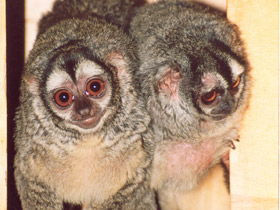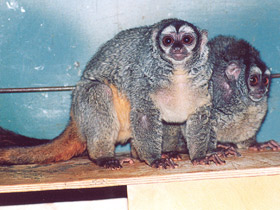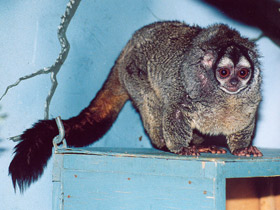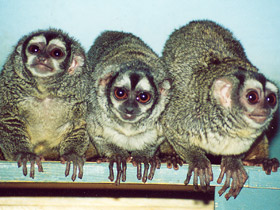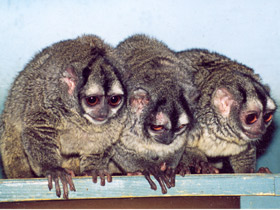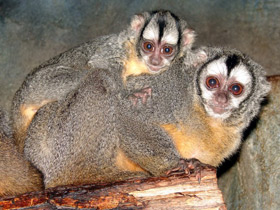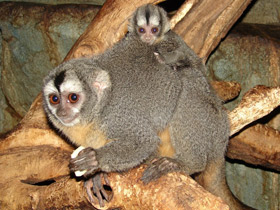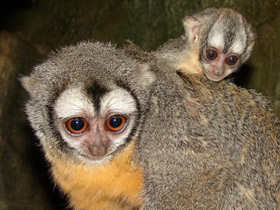Night monkeys, owl monkeys or douroucoulis (the genus Aotus)
Night monkeys, also known as owl monkeys or douroucoulis (/duːruːˈkuːliz/), are nocturnal New World monkeys of the genus Aotus, the only member of the family Aotidae (/eɪˈɒtɪdiː/). The genus comprises eleven species which are found across Panama and much of South America in primary and secondary forests, tropical rainforests and cloud forests up to 2,400 metres (7,900 ft). Night monkeys have large eyes which improve their vision at night, while their ears are mostly hidden, giving them their name Aotus, meaning "earless".
Night monkeys are the only truly nocturnal monkeys with the exception of some cathemeral populations of Azara's night monkey, who have irregular bursts of activity during day and night. They have a varied repertoire of vocalisations and live in small family groups of a mated pair and their immature offspring. Night monkeys have monochromatic vision which improves their ability to detect visual cues at night.
Night monkeys are threatened by habitat loss, the pet trade, hunting for bushmeat, and by biomedical research. They constitute one of the few monkey species that are affected by the often deadly human malaria protozoan Plasmodium falciparum, making them useful as non-human primate experimental subjects in malaria research. The Peruvian night monkey is classified by the International Union for Conservation of Nature (IUCN) as an Endangered species, while four are Vulnerable species, four are Least-concern species, and two are data deficient.
Taxonomy
Until 1983, all night monkeys were placed into only one (Aotus lemurimus) or two species (Aotus lemurinus and Aotus azarae). Chromosome variability showed that there was more than one species in the genus and Hershkovitz (1983) used morphological and karyological evidence to propose nine species, one of which is now recognised as a junior synonym. He split Aotus into two groups: a northern, gray-necked group (Aotus lemurinus, Aotus hershkovitzi, Aotus trivirgatus and A. vociferans) and a southern, red-necked group (Aotus miconax, Aotus nancymaae, A. nigriceps and A. azarae). Arguably, the taxa otherwise considered subspecies of Aotus lemurinus – brumbacki, griseimembra and zonalis – should be considered separate species, whereas Aotus hershkovitzi arguably is a junior synonym of Aotus lemurinus. A new species from the gray-necked group was recently described as Aotus jorgehernandezi. As is the case with some other splits in this genus, an essential part of the argument for recognizing this new species was differences in the chromosomes. Chromosome evidence has also been used as an argument for merging "species", as was the case for considering infulatus a subspecies of A. azarae rather than a separate species. One extinct species is known from the fossil record.
Classification
Family Aotidae
- Genus Aotus
- Aotus lemurinus (gray-necked) group:
- Gray-bellied night monkey, Aotus lemurinus;
- Panamanian night monkey, Aotus zonalis;
- Gray-handed night monkey, Aotus griseimembra;
- Hernández-Camacho's night monkey, Aotus jorgehernandezi;
- Brumback's night monkey, Aotus brumbacki;
- Three-striped night monkey, Aotus trivirgatus;
- Spix's night monkey, Aotus vociferans;
- Aotus azarae (red-necked) group:
- Azara's night monkey, Aotus azarae;
- Peruvian night monkey, Aotus miconax;
- Nancy Ma's night monkey, Aotus nancymaae;
- Black-headed night monkey, Aotus nigriceps;
- Group Incertae sedis:
- †Aotus dindensis.
- Physical characteristics.
Night monkeys have large brown eyes; the size improves their nocturnal vision increasing their ability to be active at night. They are sometimes said to lack a tapetum lucidum, the reflective layer behind the retina possessed by many nocturnal animals. Other sources say they have a tapetum lucidum composed of collagen fibrils. At any rate, night monkeys lack the tapetum lucidum composed of riboflavin crystals possessed by lemurs and other strepsirrhines, which is an indication that their nocturnalitiy is a secondary adaption evolved from ancestrally diurnal primates.
Their ears are rather difficult to see; this is why their genus name, Aotus (meaning "earless") was chosen. There is little data on the weights of wild night monkeys. From the figures that have been collected, it appears that males and females are similar in weight; the heaviest species is Azara's night monkey at around 1,254 grams (2.765 lb), and the lightest is Brumback's night monkey, which weighs between 455 and 875 grams (1.003 and 1.929 lb). The male is slightly taller than the female, measuring 346 and 341 millimetres (13.6 and 13.4 in), respectively.
Ecology
Night monkeys can be found in Panama, Colombia, Ecuador, Peru, Brazil, Paraguay, Argentina, Bolivia, and Venezuela. The species that live at higher elevations tend to have thicker fur than the monkeys at sea level. Night monkeys can live in forests undisturbed by humans (primary forest) as well as in forests that are recovering from human logging efforts (secondary forest).
Distribution
A primary distinction between red-necked and gray-necked night monkeys is spatial distribution. Gray-necked night monkeys (Aotus lemurinus group) are found north of the Amazon River, while the red-necked group (Aotus azare group) are localized south of the Amazon River. Red-necked night monkeys are found throughout various regions of the Amazon rainforest of South America, with some variation occurring between the four species. Nancy Ma's night monkey occurs in both flooded and unflooded tropical rainforest regions of Peru, preferring moist swamp and mountainous areas. This species has been observed nesting in regions of the Andes and has recently been introduced to Colombia, likely as a result of post-research release into the community. The black-headed night monkey is also found mainly in the Peruvian Amazon (central and upper Amazon), however its range extends throughout Brazil and Bolivia to the base of the Andes mountain chain. Night monkeys such like the black-headed night monkey, generally inhabit cloud forests; areas with consistent presence of low clouds with a high mist and moisture content which allows for lush and rich vegetation to grow year round, providing excellent food and lodging sources. The Peruvian night monkey, like Nancy Ma's night monkey, is endemic to the Peruvian Andes however it is found at a higher elevation, approximately 800–2,400 metres (2,600–7,900 ft) above sea level and therefore exploits different niches of this habitat. The distribution of A. azare, extends further towards the Atlantic Ocean, spanning Argentina, Bolivia and the drier, south western regions of Paraguay, however unlike the other red-necked night monkey species, it is not endemic to Brazil.
Sleep sites
During the daylight hours, night monkeys rest in shaded tree areas. These species have been observed exploiting four different types of tree nests, monkeys will rest in; holes formed in the trunks of trees, in concave sections of branches surrounded by creepers and epiphytes, in dense areas of epiphyte, climber and vine growth and in areas of dense foliage. These sleeping sites provide protection from environmental stressors such as heavy rain, sunlight and heat. Sleeping sites are therefore carefully chosen based upon tree age, density of trees, availability of space for the group, ability of site to provide protection, ease of access to the site and availability of site with respect to daily routines. While night monkeys are an arboreal species, nests have not been observed in higher strata of the rainforest ecosystem, rather a higher density of nests were recorded at low-mid vegetation levels. Night monkeys represent a territorial species, territories are defended by conspecifics through the use of threatening and agonistic behaviours. Ranges between night monkey species often do overlap and result in interspecific aggressions such as vocalizing and chasing which may last up to an hour.
Diet
Night monkeys are primarily frugivorous (fruit eating species) as fruits are easily distinguished through the use of olfactory cues, but leaf and insect consumption has also been observed in the cathemeral night monkey species A. azare. A study conducted by Wolovich et al., indicated that juveniles and females were much better at catching both crawling and flying insects than adult males. In general, the technique used by night monkeys in insect capturing is to use the palm of the hand to flatten a prey insect against a tree branch and then proceed to consume the carcass. During the winter months or when food sources are reduced, night monkeys have also been observed foraging on flowers such as Tabebuia heptaphylla, however this does not represent a primary food source.
Reproduction
In night monkeys, mating occurs infrequently, however females are fertile year-round, with reproductive cycles range from 13 to 25 days. The gestation period for night monkey is approximately 117– 159 days but varies from species to species. Birthing season extends from September to March and is species-dependent, with one offspring being produced per year; however, in studies conducted in captivity, twins were observed. Night monkeys reach puberty at a relatively young age, between 7 and 11 months, and most species attain full sexual maturity by the age of 2 years of age. A. azare represents an exception reaching sexual maturity by the age of 4.
Behavior
The name "night monkey" comes from the fact that all species are active at night and are, in fact, the only truly nocturnal monkeys (an exception is the subspecies of Azara's night monkey, Aotus azarae azarae, which is cathemeral). Night monkeys make a notably wide variety of vocal sounds, with up to eight categories of distinct calls (gruff grunts, resonant grunts, sneeze grunts, screams, low trills, moans, gulps, and hoots), and a frequency range of 190–1,950 Hz. Unusual among the New World monkeys, they are monochromats, that is, they have no colour vision, presumably because it is of no advantage given their nocturnal habits. They have a better spatial resolution at low light levels than other primates, which contributes to their ability to capture insects and move at night. Night monkeys live in family groups consisting of a mated pair and their immature offspring. Family groups defend territories by vocal calls and scent marking.
The night monkey is socially monogamous, and all night monkeys form pair bonds. Only one infant is born each year. The male is the primary caregiver, and the mother carries the infant for only the first week or so of its life. This is believed to have developed because it increases the survival of the infant and reduces the metabolic costs on the female. Adults will occasionally be evicted from the group by same-sex individuals, either kin or outsiders.









